A couple of weeks ago the French branch of The Council met at the Maison des Métallos in Paris to discuss about the challenges and promises of ‘the internet of things.’ There were presentations by artists, hackers, designers, researchers and also by various people in suits. The highlight of the event for me (and for many other people i’m sure) was a presentation by Jean-Baptiste Labrune on DIY Transducers.
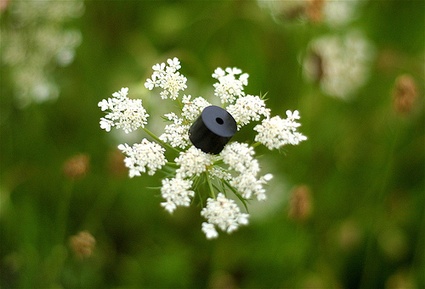 Piezo Flower. Image by JB Labrune
Piezo Flower. Image by JB Labrune
Currently working for Alcatel-Lucent Bell Labs, Dr Jean-Baptiste Labrune has recently traveled back to Paris after a couple of years spent as a postdoctoral researcher in the Tangible Media Group at the MIT Medialab. The Council was not our first encounter, I had met the French computer scientist before at interaction design workshops, media art conferences, dorkbot meetings and in other events where hackers, artists, designers and engineers might want to hang out and discuss.
His presentation gave a provocative (and much welcome) twist to the discussion about ‘the internet of things.’ Labrune’s talk revolved around the idea of developing organic circuits and, more broadly, about an internet of thing which might one day be made of materials that grow, evolve, decay and die just like us.
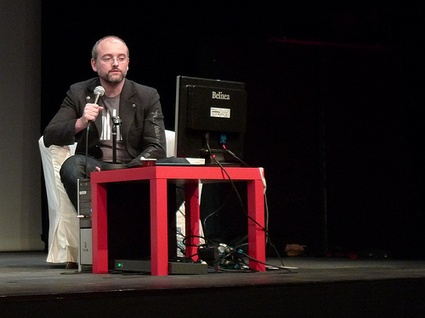 Jean-Baptiste Labrune at The Council. Image by Pierre Metivier
Jean-Baptiste Labrune at The Council. Image by Pierre Metivier
Labrune manages to be very witty, very geek and very funny at the same time. The chaotic notes i took during his presentation are, alas!, unable to reproduce his style and ideas so I thought it would be best if i’d have him speak in a super short interview about his work:
One of the projects you developed while researching at MIT was a reflection on electronic components that wouldn’t be made of plastic nor metal but of natural materials? Can you tell us about the outcome of that research? What did your prototypes look like?
Because of their homogeneous hence controllable nature, many modern objects are made using the same materials, like plastic for example. Fabrication line-ups engineers like to control i.e. predict in advance the rate of failure and in a way eliminate error from the production process of high-end artefacts. Because I think that our capacity to repurpose unpredictability into meaning is what makes us human by opposition to machine, I was exploring in this project how using less controllable process and materials might lead to different results than traditional techniques for electronics like PCB for instance. Among the prototypes, I try to develop simple circuits with simple functions to more complex ones with microcontrollers or microchip programmers. I was also interested in creating unstable sensors and actuators made out of wood for instance where regular components would be only press-fit and connected to the circuit trace by dry-paint and not solder joints, allowing young children to create simple electromechanical artefacts without soldering irons or chemical etchant.
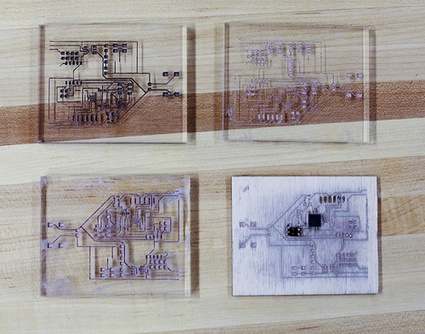 Four Copper Preg LaserCut Boards. The one in the down right is wood, other are PMMA (acrylic). Image JB Labrune
Four Copper Preg LaserCut Boards. The one in the down right is wood, other are PMMA (acrylic). Image JB Labrune
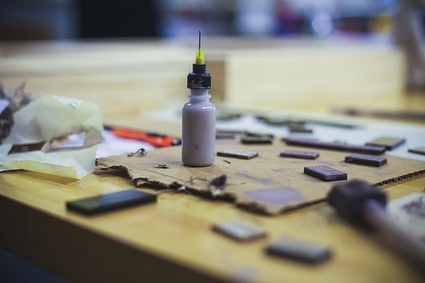 Liquid copper. Image JB Labrune
Liquid copper. Image JB Labrune
You employed a rather unusual material, some kind of liquid copper? Can you explain it its role in your prototype?
Some of my colleagues and friends (Leah Buechley, Hannah Perner-Wilson, Nadya Peek) are the best in collecting nice stuff that conduct electricity like all kind of liquid suspensions, animal exoskeletons or felted particles… I realised different prototypes of circuits boards using liquid copper since with silver, this metal is a very good conductor of electricity, which we like in general (except if you want to make resistive sensors). The particular one used in the project you mentioned is the moderately cheap CuPro-CoteTM paint from LessEMF, a website specialised in anti-abduction garments, well known from electronic textile folks since it proposes all kind of nice conductive fabric based on copper or silver with beautiful and strange names like Flectron or Zelt. Because it is almost entirely composed of copper, this paint is in principle not dangerous for health since copper can even be moderately ingerated (in principle :). Leah Buechley and her research group frequently use it to make paper electronics by directly painting circuits on paper with such paints. My idea was to use a fast CNC machine (like a laser cutter for example) to quickly draft electronic objects since this kind of machines are precise and good at repetitive tasks, and then let a human finish them since they are usually very good at the inverse, therefore creating an interesting tension between repeatability and originality. The boards were made out of different materials with various hydrophobic or hydrophilic surfaces (PMMA, Wood, BioComposites) inviting the liquid copper to go into machine cut channels according to precise paths. The precision of the CNC machines I used allowed to create rather compact circuits at SOIC or even QFN pitch (which corresponds to most of artistic grade electronic components) but also, and interestingly enough to develop precise high frequency antennas or very precise solenoids (electromagnets) by simple depositions, which led me for example to create monolithic speakers from wood and copper in a following project.
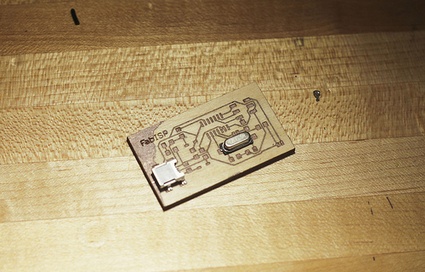 Simple implementation of the FabISP made by David A. Mellis in a HTMAA class. Image JB Labrune
Simple implementation of the FabISP made by David A. Mellis in a HTMAA class. Image JB Labrune
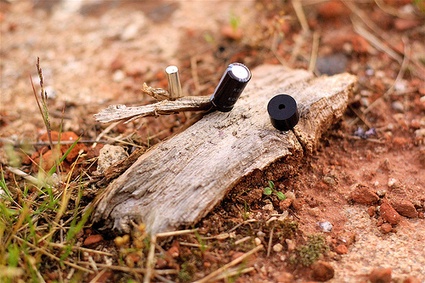 Wooden PCB. Image JB Labrune
Wooden PCB. Image JB Labrune
Was your project motivated by a strong sense of ecology and respect for nature?
Well, I am not sure it was motivated by nature or ecology in the greenwashing sense, but more in the idea of situatedness (à la Lucy Suchman), or as Von Huexküll puts it in the beginning of the last century, in terms of non-forgetting the idea of Umwelt, where an object is as defined by everything it is not than by its internal or intrinsic components. Let say that I was motivated by these ideas and also by the desire of a playful drift from the ubiquitous idea of cybernetics, theory of governance and control (kybernetika, the art of steering), minimising the presence of predictive control (feedforward, feedback, negative-feedback) by systems or their operators, while, like in poetic cybernetics, celebrating human abilities to appreciate scale-invariance, navigate through intricate recursive assemblages and adapt to ad-infinitum changes. A second perspective is the ability to create processes or machines that intervene into natural environment but then withdraw themselves to let their artificiality being re-conquered by living entities, controlled by extra-human rules. I am thinking here for example of the works of land art researchers and artists like Philip Beesley for instance who comes to forests on deserted islands with many students, knit their roots and then go for many years to finally come back and see how nature interpreted their interpretations.
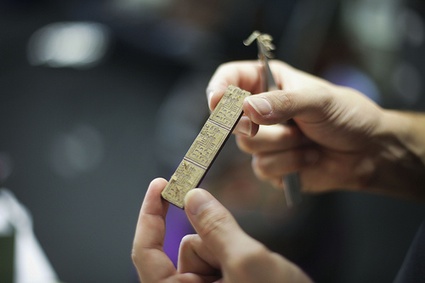 Cardboard Hello. Image JB Labrune
Cardboard Hello. Image JB Labrune
How do you think users will relate to tech components that are going to ‘grow old’ and ‘die’? Do you feel they will care for them more? Develop an altogether different relationship to technology?
One of the outcome of this quick investigation of electronic devices made out of wood for instance is the idea that if we would make circuits on living entities, they would perform differently according to the environment or the homeostatic state of the substrate. This will lead to situations where regular objects that usually are our slaves and perform their function in a controlled and predictable manner would then resist to us, fail to obey to our desires or the anticipated ones designed by technological designers. This resistance might anthropomorphise them and maybe create a feeling of empathy due to the then finite nature of the object relation, that might stop if not nurtured or a least manifested and preserved. Anthropologues and thinkers such as Donna Haraway, Bruno Latour or Michel Serres frequently remind us of the political nature of nature. In the electric or electronic field, luxuriant and drifting definitions of nature are often replaced by an efficient determinist ballistic culture. What if technology to come would integrate natural substrates? Would it transform human sophisticated illusion of control and wishes to tell the future as a serious fiction? Maybe it will actually be the limits of technology that will invite users, as humans, to re-question their relationship with modern environments, especially when most of them are now created by other humans.
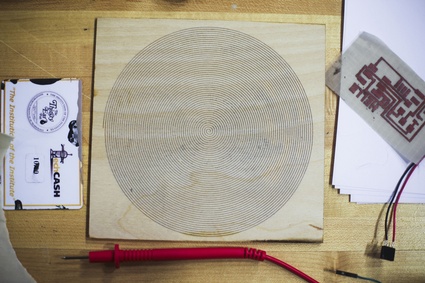 Solenoid test (50 spires) is to show whether laser engraving can create precise circuits to make magnetic coil, inductors and even pretty high frequency antenna (for RFID, Radio, etc.) Image JB Labrune
Solenoid test (50 spires) is to show whether laser engraving can create precise circuits to make magnetic coil, inductors and even pretty high frequency antenna (for RFID, Radio, etc.) Image JB Labrune
Merci Jean-Baptiste!
More: Slideshare of DIY Transducers, flickr set on Lasercutting, and Orgatronics.
Related: Interactivos? Garage Science: the Fruit Computer Laboratory.
